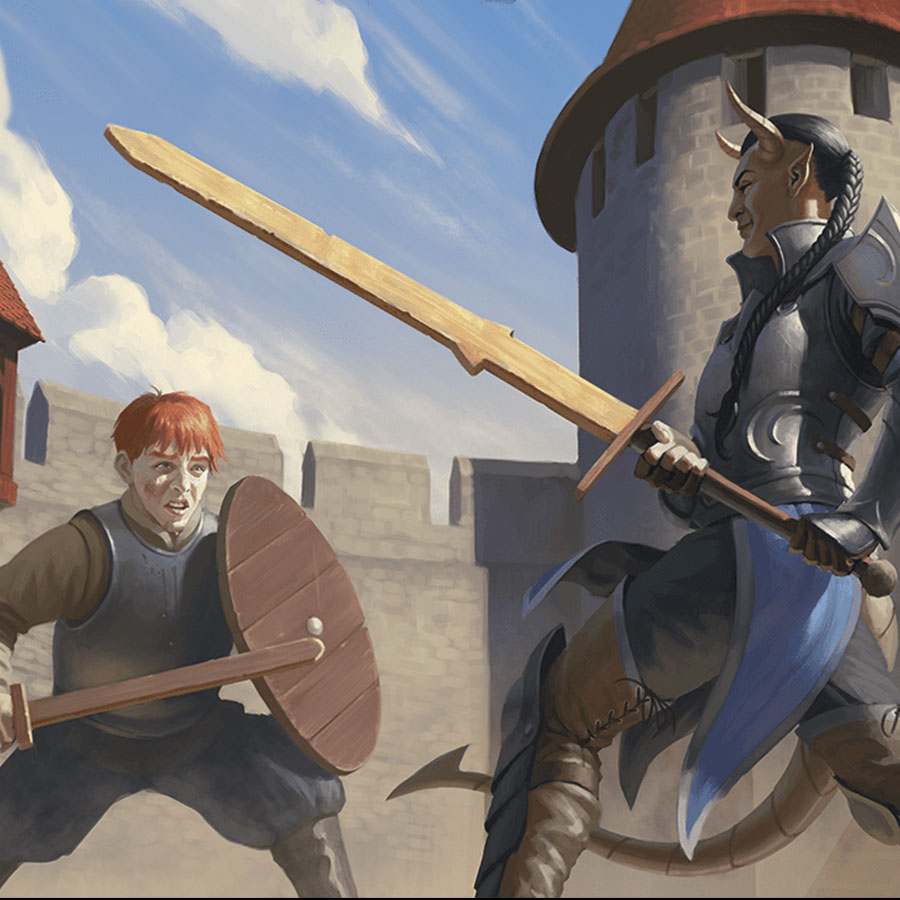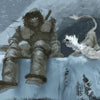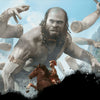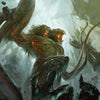How to Make Players Fall in Love with Your D&D Game World

Written by Luke Hart
Are you frustrated that your players sometimes don’t seem to care about your game world? Perhaps your players get really excited about their characters’ cool new abilities and spells – or the magic items they just looted – but your game setting is a sideshow at best. Well, today we’re going to discuss a simple trick you can use to make your players actually care about the game world, and perhaps even begin to love it.
Now, this trick actually has nothing to do with the details of your game world itself. You could be running your game in Eberron, Golarion, or your own homebrew setting. It doesn’t matter because what we’re going to be talking about today is EVOLVING your world based on CHARACTER DECISIONS.
In my experience, this is the factor that takes a setting from something that is merely a rather unimportant backdrop for the players, and ELEVATES the game world to something that players become invested in and actually care about.
Watch or listen to this article by clicking the video below.
The essence of this method involves the game master considering what player characters have said and done in the game world and then asking themselves, “How would my world change as a result? And is that change positive or negative?”
When the characters stop a war or prevent a lich from destroying a city and raising an undead horde, the king throws them a party, hands over the key to the treasury, and the crowd goes wild. But what happens when they fail? What happens when the war rages on or the lich succeeds in his diabolical plan? And even when the characters win, how does this affect the world at large? What are the positive and negative impacts of their successes or failures? And how do those impacts change the world in which the campaign is taking place – or in which your NEXT campaign will take place?
You see, characters make many choices. They have their own goals, sometimes ones that even conflict with each other character’s goals. They make allies, make enemies, are betrayed, and sometimes are even the betrayers. They may come into a town, go to the local temple, and buy out all the healing potions that the clerics have in stock. They may throw gold around like it’s candy or murder-hobo their way through town. A character may rise from a race usually hostile to humanity to become a hero of the kingdom – or be of a traditionally admired class only to abuse their power or accidentally decimate a city. It's up to you, the game master, to decide how these activities affect the campaign and the world.
However, here’s the thing: the scope and impact of character’s actions is going to change over the course of the game. When characters are low level, the change they are able to affect on the world is limited to the local town perhaps; however, as they grow in power and levels, their impact on the world will be greater.
Fifth edition defines the tiers of play as follows: "local heroes" are levels 1 - 4, "heroes of the realm" are levels 5 - 10, "masters of the realm" are levels 11 - 16, and "masters of the world" are levels 17 - 20. These titles are meant to provide the game master guidance on the scope of the characters' adventures and the extent of their influence on the world. The game master can use their levels to impact the game world’s evolution based on their actions. As the campaign progresses through the tiers, the game master should consider the good and bad implications of the players' choices and resulting character actions.
Now, what we’re going to do here is FIRST briefly discuss each of the four tiers of play, touching on the sorts of evolutions in the game world a game master might bring about. And THEN we’re going to discuss 10 different categories of change that a GM can make in their game world; these 10 categories will give us some more tangible and implementable ideas for changes we could make to the world.
Tier One: Local Heroes
At this tier, the characters' actions resulting from the players' choices gain them fame and influence on the local scale. This could mean a town, city, or local region, but the impact isn't likely to extend beyond that. Nevertheless, there are plenty of opportunities for the characters' actions to influence the game world long term.
A town that is no longer being threatened by local orc tribes can prosper and grow into a bustling city in a matter of years. A city freed from a corrupt priest secretly running an infernal cult under cover of a mighty temple to a benevolent goddess can result in a void of religious power that finds itself filled by a new faith that could change the entire course of their social development. And a region that suddenly finds itself saturated with adventurer's gold could see a long-term boom in their economy or a crash leading to economic ruin.
Or what if that region, suddenly rich with the gold of adventurers that have now moved on to bigger places and things, attracts the attention of a red dragon that wants that wealth for itself? An ancient or adult dragon can drastically reshape a region’s politics, population, and landscape. The evolutionary effects of the players' choices don't have to be the most logical course of action in worlds of fantasy and wonder... but they should be wondrous and fantastic.
Tier Two: Heroes of the Realm
When the characters enter the second tier of play, their influence expands to the entire realm. The concept of a "realm" isn't clearly defined, nor should it be, as it means different things to different settings and campaigns. Usually, a realm is considered a kingdom, empire, or collection of cities. Still, it could be a small collection of widespread duchies in conflict with each other, the entire coastal region of a continent, or a massive desert and the many nomadic people who wander its sun-beaten landscape.
Regardless of how the realm is defined, the impact of the players' decisions will affect the world on a larger scale. It's less likely that adventurers throwing around money will affect the region’s economy and more likely that the characters’ actions need to be more significant and more overt to have a more lasting effect. But that's fine because, at this level, that's precisely what the characters should be doing: freeing the roads from a bandit queen rather than a few highwaymen, unseating evil kings, and bringing an end to a coastal herd of perytons hunting the crews of merchant ships.
If the statistics are to be believed, most campaigns end in this tier or shortly into the next, so this is often where a game master must focus their efforts on evolving the world. Because of that, it is even more vital for them to think about the impacts of their players' choices in this tier. The end of the bandit queen or perytons will allow caravans and trade to flow more readily; however, it also changes the predator/prey dynamic of the region, and nature abhors a vacuum. After all, the players should see the benefits of their victories as the world evolves, but the next campaign will still need adventures for them to undertake as well.
Tier Three: Masters of the Realm
Much like the word realm, the transition from "hero" to "master" is also poorly defined. The most noticeable difference is often that those in power are no longer hiring the characters to solve their problems but are seeking the characters' advice on solving those problems. The heroes have transitioned from agents to advisors, often given the freedom to act on behalf of the leadership of a nation without a direct request.
It may be time to hunt down that red dragon that has taken over the region where the game started. More likely, the time has come for old enemies to return, allies to come together to face their destinies, and the heroes’ final battle against the big bad of the campaign to bring their machinations to an end or fail in the attempt. Regardless of the events, the repercussions of the players' choices should impact the realm for generations to come.
When the heroes finally confront the big bad of the campaign, how will that day be remembered? Will their victory become a future holiday celebrated across the kingdom? Will the fallout of that battle be long felt in the region as a zone of wild magic springs up around the lich's now-shattered phylactery? Or will their defeat turn the entire kingdom into a necropolis led by a terrible archlich? While the consequences of the players' choices, good and bad, don't have a broader REACH in this tier than the previous, they should have a more significant IMPACT.
Tier Four: Masters of the World
As the players enter the final tier of play, their characters are practically demigods... at least, compared to the rest of the world. The scope of their adventures and the influence of their actions are world-spanning. They should have widespread effects: major nations rise and fall, lesser deities fall as new ones rise to replace them, and magical cataclysms change the world forever. The game master should be prepared to evolve the world in ways that will be reflected for many campaigns to come and, perhaps more importantly, should be willing to do so.
At this tier, players' choices impact the world that the game master has created or adapted to be their own. At this point, more than any other, the game master must be willing to let go of their "baby" and let the characters' actions help it grow. This can be difficult for some game masters, especially those who have grown attached to their creations, but it is an important lesson and task if the players are to feel that their choices truly matter.
Hopefully, by now, players are making "good choices" that promote positive growth and change in the world. The orc who turned their back on their race’s dark gods has the chance to show the world that not all orcs are evil. In a world where magic is feared or mistrusted, the wizard has their moment to demonstrate that their art is only as good or bad as the person who wields it. But on the other side, "bad choices" will have the same level of effect. That same wizard, should they decide to cast fireball in a town square filled with innocent civilians, could cause arcane magic to be outright illegal in the future. Victories will be celebrated worldwide, but defeat can result in the literal end of the world.
How Exactly to Evolve a Game World
Providing concrete rules on how to evolve a game world is nearly impossible. Every world is different, every campaign distinctive, and there is no limit to players' choices. Nevertheless, here are 10 CATEGORIES of change that you may wish to consider. These are areas in which you should think about evolving your world, based on player character actions.
1. Change in Political Power
The political leadership of a region changes hands, the leader of a region changes their attitude or beliefs, or unjust law is changed, all for the betterment OR detriment of society.
2. Change in Religious Power
The religious leadership of a region changes hands, one faith loses prominence as another takes its place, or the morality of the region takes a turn for the better, all for the betterment OR detriment of society.
3. Change in Regional Economy
Dwindling commerce in the region is restored, a new guild comes into prominence, or an austere region with poor living conditions is given an economic boost that improves the lives of its citizens. OR A major trade route is destroyed, a powerful guild upon which a city is dependent closes its doors, or a prosperous society suffers massive economic devastation.
4. Change in Social Attitudes
A race or class previously shunned gains a positive reputation, dangerous activities once considered acceptable are rejected by the populace, or a self-serving nobility becomes more charitable. OR New prejudices rise or old ones deepen against a race or class of adventurer, harmful activities once taboo are embraced by a society, or fear descends upon a once-content people.
5. Change in Military Posture
A poorly defended region has its military bolstered, an oppressed region is now free to restore its martial autonomy, or a beleaguered and besieged army has been relieved. OR War leaves a region's military in shambles and ripe for conquest, a draft is implemented forcing families to surrender their eldest children to the military, or martial law is declared in a region.
6. Change in Regional Environment
A plague, famine, or drought is ended; powerful, unpredictable storms become a thing of the past; or the sun finally rises on an eternal winter. OR Flourishing farmland is razed and salted leaving an agricultural society in ruins, unseasonable weather brings a region to a commercial standstill, or a shift in the tides floods a coastal city.
7. Change in Underworld Influence
A powerful thieves guild is brought down, a powerful bandit nation's influence is ended, or a despicable leader of the local thieves is replaced by someone more moderate or philanthropic. OR A notorious thieves guild gains political power, a lazy bandit king is succeeded by a violent and ambitious rival, or a philanthropic leader of the local thieves is replaced by a greedy sociopath.
8. Change in Regional Ecosystem
An ecosystem is stabilized as a dominant, powerful predator ceases to be an issue; a benevolent dragon replaces a tyrannical one; or a pestilence affecting livestock finally ends. OR A powerful predator dies and opens the door to something worse; a fishing community finds their waters empty of fish; or the death of a predator causes an intrusive overpopulation of herd animals.
9. Change in the Arcana
A region of wild magic is stabilized, tears in the fabric of space allowing demons to cross into the mortal world are mended, or the nature of magic is changed to make it easier to wield. OR Magic is destabilized causing unpredictable surges of wild magic; the fabric of space is torn open causing an influx of unseelie fey; or the nature of magic changes making it more difficult to control.
10. Change in Regional Geography
A raging river is dammed and brought under control, a new mountain rises into the sky bringing new resources to the surface, or an arid valley becomes agriculturally viable. OR An earthquake separates a town from its protectorate, a population is eradicated, and their city left in ruins; or a mountain range falls into the sea forever altering the coastline.
Get Loads of 5e Adventures and Resources for Your Games!
As a new dungeon master, I was overwhelmed with everything I needed to do. Learn the rules, create the adventures, run the game, handle problem players—it was A LOT! And even as a veteran DM, it’s still a lot. You might even feel that way yourself.
If you’re looking for loads of 5e adventures that you can prep in under 30 minutes or elements such as traps, puzzles, and encounters that you can drag and drop into your game at a moment’s notice, we have you covered!
With Lairs & Legends and Loot & Lore, you’ll get over 700 pages of 5e resources:
- Twenty-nine 5e adventures spanning levels 1 to 15 and designed for groups of 4 to 6 players.
- Over 100 new creatures from CR 0 to CR 24.
- Adventure Ideas
- Encounters with Full-Color and Blackline Digital Maps
- Patrons & Factions
- Magic Items
- NPCs
- Puzzles
- Random Encounter Tables
- Random Tables
- Spells
- Subclasses
- Traps
- Villains
Everything is designed to be EASY TO USE and QUICK TO PREP for your game. Our goal is to make game masters’ lives easier, not more complex!
Don’t spend another moment frustrated and overwhelmed as a GM. Pick up the Lairs & Legends Ultimate Bundle today and find out how much easier being a GM can be!
-
Posted in
Game Master How-To Articles







